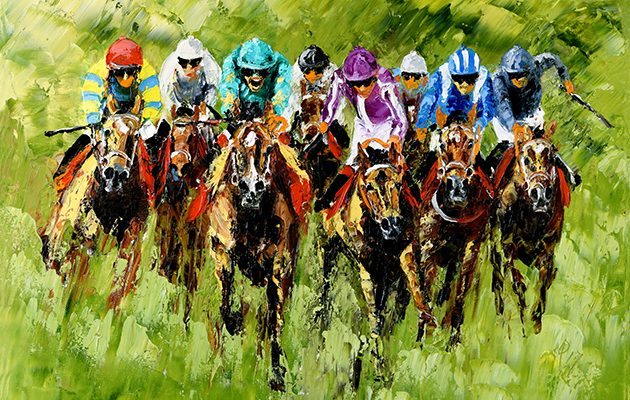Michael Parker tells Janet Menzies why he has swapped plaster for oil paint, working plein air to create gloriously textured scenes
Michael Parker owes his artistic technique to a much more undervalued skill: laying fresh plaster. Working plein air and ending the day covered in paint, there is still much of the businesslike builder in this sporting artist, as Janet Menzies discovers.
For more sporting artists, John Skeaping’s work has become more widely accessible due to a chance encounter at Cheltenham. And Tristram Lewis swapped paint for plasticine to immortalise a great racehorse in bronze. To view Michael Parker’s current portfolio, visit his website.
MICHAEL PARKER

‘Casting into the Shallows’.
Anybody planning a new building project should be sure to hire an artist immediately. All the great Renaissance patrons knew this: Ludovico Sforza, the Medici family, Pope Julius II. Undeniably, Michelangelo was a brilliant stone mason and you can hardly argue with Leonardo’s plasterwork. As for Raphael, many critics praise his project-management skills as a vital part of his success. Impressionist sporting artist Michael Parker would be the last to put himself in that league but there is no doubt about his plastering, bricklaying and building-project abilities.
Parker explains: “Right from school I was interested in being an artist but we weren’t that sort of family. So I was a bricklayer when I started and then worked my way up from there to my own business as a housing developer.” But Parker’s creativity wouldn’t be kept down. He brought thatch back into Dorset as a modern material and his Michael Parker Homes have won many awards. “I am an honorary member of the Master Thatchers Association Dorset,” he says with pride.
“I always kept up with my painting while I was growing the business but paintings don’t pay bills, so the art had to take second place for a while. Then I reached the point where I was beginning to think the time has come where I am able to do things my own way.”

‘Tiggy Wiggy’.
The reduced profitability of building after the crash helped make up Parker’s mind and building’s loss was the art world’s gain. He soon found his skills were wonderfully transferable. “I work with a palette knife in oil paint, wet on wet,” he explains, “and all that plastering I did in my youth has come in handy because I do know how to hold a palette knife and use one. When you are plastering in difficult places you have to be able to hold the trowel in a special way to get the angles you need, and that has come through in my painting.”
His artistic technique – working quickly while the oils are still wet and layering his impasto – clearly owes a lot to the under-valued skill of laying fresh plaster. Parker describes his method: “You have to plan the painting beforehand, and I will probably do a pencil sketch on the canvas, but then once you start you have to work quickly – you are working wet on wet and I use my oil thickly so if you let it start going off it gets tacky.” Parker’s speed of working is reflected in the love of movement in his art. “I think that is probably what drew me towards sporting art. I have always had horses and I love showing their athleticism and with fishing I want to capture that moment where the movement is almost suspended – when you are just about to strike on a fish. I want to express the feeling you get just as the fish is coming into the fly. And I love creating all the reflections of the water, I think that’s something that works well with my technique.”

‘Springer Spaniel Hunting’.
Recently, Parker has moved into using a whole new range of colours, so his most recent work has an impressionistic, almost pointillist, feel. “I’ve discovered how colours work with each other and now I am using just pure violets, cadmium, reds, greens and blues, which come together as the painting develops. I have all sorts of palette knives – big ones and even kitchen spatulas. I work outdoors, known as ‘plein air’ and it’s quite physical. I always end up getting covered in paint like a builder.”
Parker’s enthusiasm for his painting infuses his work with a positivity that is appealing to the viewer and he’s keen that it should be seen as much as possible. “I have won various competitions and my work is on sale up and down the country. The next stage is to get on as many people’s walls as possible. I have always been a businessman and I still like to be businesslike about my art even though I enjoy it so much.”
Those great Renaissance painters and their patrons would be nodding in agreement: art is hard work.





